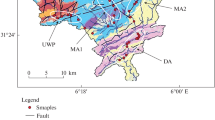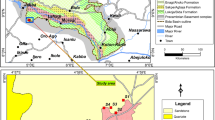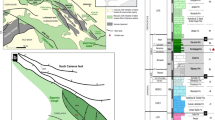Abstract
The Upper Cretaceous (Maastrichtian) Whitemud Formation is a potentially commercial kaolin deposit located in southern Saskatchewan and southeastern Alberta. The Whitemud Formation contains a lower kaolinitic sandstone, a middle lignite and carbonaceous shale, and an upper interbedded siltstone and claystone. The sediments that comprise the rocks of the Whitemud Formation were deposited on alluvial or upper deltaic plains located along the northwest flank of the Williston Basin.
Mineralogy and textures were determined by X-ray powder diffraction, scanning electron microscopy, and optical microscopy. Kaolinite abundance increases upward from the underlying rocks of the Eastend Formation through the Whitemud Formation, and the abundance of smectite, micas, and feldspars decreases from the Eastend Formation into the Whitemud Formation. Vermiform kaolinite crystals are in close spatial association with feldspar and mica grains. Near the top of the Whitemud Formation, etched quartz and feldspar grains, and gibbsite suggest the presence of a strong chemical leaching environment.
Mineral distributions, presence of root remains, pédologie mottles, grain coatings composed of clay, and soil horizons indicate the Whitemud Formation sediments were modified by intense weathering in a paleosol environment.
Kaolin concentrated from selected kaolinitic sandstone deposits, and beneficiated by oxidation, leaching, and high-intensity wet-magnetic separation has a product brightness up to filler quality. Recovery of lowabrasion kaolin is low and viscosity of a fine-particle kaolin fraction is high. Economics of producing a wet-processed filler-grade kaolin is marginal.
Similar content being viewed by others
References
Banfield, J. F. and Eggleton, R. A. (1988) Transmission electron microscope study of biotite weathering: Clays & Clay Minerals 36, 47–60.
Berry, E. W. (1935) A preliminary contribution to the floras of the Whitemud and Ravenscrag Formations: Geol. Surv. Can., Memoir 182, 107 pp.
Broughton, P. L. (1977) Origin of coal basins by salt solution: Nature 270, 420–423.
Broughton, P. L. (1979) Origin of coal basins by salt solution tectonics in western Canada: Ph.D. dissertation, University of Cambridge, Great Britain, 273 pp.
Buol, S. W., Hole, F. D., and McCracken, R. J. (1980) Soil Genesis and Classification: 2nd ed. Iowa State Univ. Press, Ames, Iowa, 404 pp.
Byers, P. N. (1969) Mineralogy and origin of the upper Eastend and Whitemud Formations of south-central and southwestern Saskatchewan and southeastern Alberta: Can. J. Earth Sci. 6, 317–334.
Fraser, F. J., McLearn, F. H., Russell, L. S., Warren, P. S., and Wickenden, R. T. D. (1935) Geology of southern Saskatchewan: Geol. Sum. Can. Memoir 176, 137 pp.
Gardner, T. W., Williams, F. G., and Hollbrook, P. W. (1988) Pedogenesis of some Pennsylvanian underclays; groundwater, topographic and tectonic controls: in Paleosols and Weathering Through Geologic Time: Principles and Applications, J. Reinhardt and W. R. Sigleo, eds., Geol. Soc. Amer., Spec. Paper 216, 81–101.
Haq, B.H., Hardenbol, J., and Vail, P.R. (1987) Chronology of fluctuating sea levels since the Triassic: Science 235, 1156–1167.
Hester, N. C. (1974) Post-depositional subaerial weathering effects on the mineralogy of an Upper Cretaceous sand in southeastern United States: J. Sedim. Petrol. 44, 363–373.
Keller, W. D. (1976) Scan electron micrographs of kaolins collected from diverse origins—III. Influence of parent material on flint clays and flint-like clays: Clays & Clay Minerals 24, 262–264.
Lerbekmo, J. F. (1987) Magnetostratigraphic restrictions on the age of the Frenchman Formation and the magnitude of the sub-Frenchman disconformity in southwest Saskatchewan: Bull. Can. Petrol. Geol. 35, 454–459.
Misko, R. M. and Hendry, H. E. (1975) The petrology of sands in the uppermost Cretaceous and Paleocene of Southern Saskatchewan: A study of composition influenced by grain size, source area, and tectonics: Can. J. Earth Sci. 16, 38–49.
Neubold, H. B., Sennett, P., and Morris, H. H. (1982) Abrasiveness of pigments and extenders: Tappi J. Dec. 1982, 90–93.
Rahmani, R. A. and Lerbekmo, J. F. (1975) Heavy-mineral analysis of Upper Cretaceous and Paleocene sandstones in Alberta and adjacent areas of Saskatchewan: in The Cretaceous System in the Western Interior of North America, W. G. E. Caldwell, ed., Geol. Assoc. Can., Spec. Paper 13, 607–632.
Reading, H. G. (1986) Sedimentary Environments and Fades: 2nd ed., Blackwell Scientific, Boston, 615 pp.
Retallack, G. J. (1988) Field recognition of paleosols: in Paleosols and Weathering Through Geologic Time: Principles and Applications, J. Reinhardt and W. R. Sigleo, eds., Geol. Soc. Amer., Spec. Paper 216, 1–20.
Shanmugam, G. and Higgins, J. B. (1988) Porosity enhancement from chert dissolution beneath neocomian unconformity: Ivishak Formation, North Slope, Alaska: Amer. Assoc. Petrol. Geol. Bull. 72, 523–535.
Spyker, J. W., Carlson, E. Y., and Babey, W. J. (1954) Separation of kaolin from kaolinized sand: Sask. Dept. Min. Res., Kept. 2, 23 pp.
Tyrrell, D. A. J. and Chanock, R. M. (1963) Transformation of montmorillonite to kaolinite during weathering: Science 141, 148–153.
Whitaker, S. H. and Pearson, D. E. (1972) Geological Map of Saskatchewan: Sask. Dept. Min. Res., and Sask. Res. Counc, 1″ = 20 miles (1:1,267,200).
Wilson, M. J. (1966) The weathering of biotite in some Aberdeenshire soils: Min. Mag. 35, 1080–1093.
Worcester, W. G. (1950) Clay resources of Saskatchewan: Sask. Geol. Surv., Industrial Miner. Div. Rept. 7, 198 pp.
Author information
Authors and Affiliations
Rights and permissions
About this article
Cite this article
Pruett, R.J., Murray, H.H. Clay Mineralogy, Alteration History, and Economic Geology of the Whitemud Formation, Southern Saskatchewan, Canada. Clays Clay Miner. 39, 586–596 (1991). https://doi.org/10.1346/CCMN.1991.0390604
Received:
Accepted:
Published:
Issue Date:
DOI: https://doi.org/10.1346/CCMN.1991.0390604




